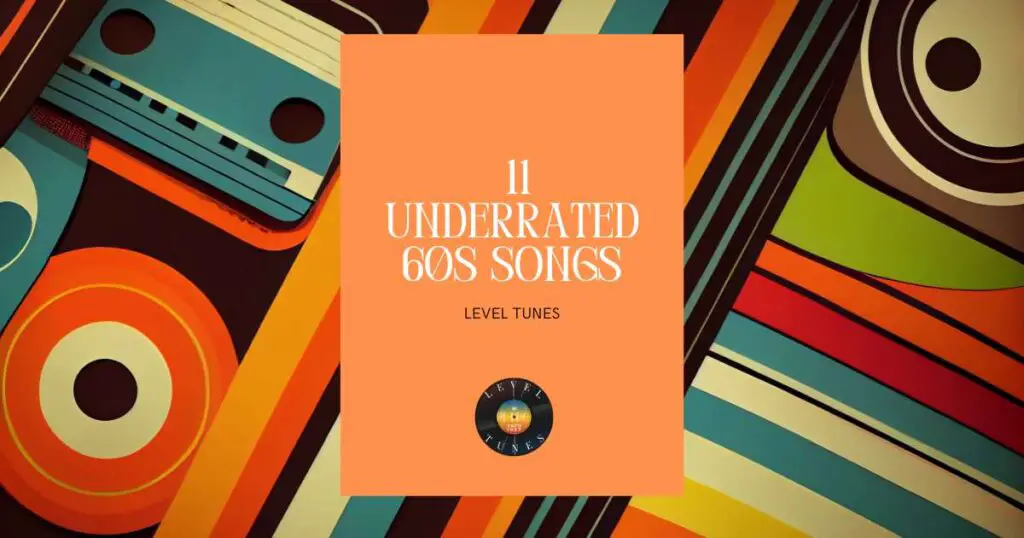11 Underrated 60s Songs: Lost 60s Tunes
Hey there, music lovers and fellow DJs! It’s TBone here from Level Tunes, and today I’m super excited to share something special with you.
As a DJ and a die-hard fan of the groovy ’60s era, I’ve always been fascinated by the hidden gems that didn’t quite make it to the mainstream spotlight. So, I’ve put together a list of 11 underrated songs from the 1960s that deserve a second listen.
These tracks are not just tunes; they’re time capsules that capture the essence of a revolutionary decade. I believe these songs, overshadowed by the era’s giants, hold their own unique charm and character.
Whether you’re spinning at a club or just chilling at home, these tracks are sure to add some vintage flair to your playlist. Let’s dive into the sounds of the ’60s that you probably haven’t heard but definitely should!
Here are the underrated 60s songs that you can check out:
List Of Underrated 60s Songs
Underrated 60s songs in a list format:
1. “She’s a Rainbow” by The Rolling Stones
Album: Their Satanic Majesties Request (1967) Label: Decca Records Why It’s Special: “She’s a Rainbow” is a psychedelic masterpiece from The Rolling Stones, a band more known for their rock and blues roots. Released in 1967, this track, featured on “Their Satanic Majesties Request,” is a colorful departure from their usual style. It’s a vibrant, piano-driven melody with a string arrangement by John Paul Jones (later of Led Zeppelin fame). The song showcases a softer, more whimsical side of the Stones, making it a unique and often overlooked gem in their catalog.
2. “Care of Cell 44” by The Zombies
Album: Odessey and Oracle (1968) Label: CBS Records Why It’s Special: The Zombies’ “Care of Cell 44” is a shining example of baroque pop from their critically acclaimed album “Odessey and Oracle.” Released in 1968, this song is a lyrical narrative about awaiting a lover’s release from prison, wrapped in upbeat, harmonious melodies that contrast with the theme. The intricate vocal harmonies and the bright, poppy piano played by Rod Argent make this track stand out. It’s a song that deserved more attention, showcasing The Zombies’ ability to blend melancholic themes with infectious melodies.
3. “Village Green” by The Kinks
Album: The Kinks Are the Village Green Preservation Society (1968) Label: Pye Records Why It’s Special: “Village Green” by The Kinks, from their 1968 album of the same name, is a nostalgic ode to simpler times and pastoral English life. Ray Davies’ songwriting shines through with its vivid imagery and longing for the past. This track is a quintessential example of The Kinks’ ability to craft songs that are both reflective and whimsical. The album didn’t gain much commercial success initially, making “Village Green” a hidden treasure in the band’s discography.
4. “Expecting to Fly” by Buffalo Springfield
Album: Buffalo Springfield Again (1967) Label: Atco Records Why It’s Special: “Expecting to Fly” is a standout track from Buffalo Springfield’s 1967 album, “Buffalo Springfield Again.” This Neil Young composition is a lush, orchestral piece that diverges from the band’s usual folk-rock sound. The song’s ethereal quality, combined with Young’s introspective lyrics, creates a dreamlike atmosphere. It’s a poignant reflection on change and lost innocence, showcasing Young’s early experimentation with different musical styles.
5. “My World Fell Down” by Sagittarius
Album: Present Tense (1968) Label: Columbia Records Why It’s Special: Sagittarius’ “My World Fell Down” from their 1968 album “Present Tense” is a psychedelic pop marvel. The project, created by Gary Usher and Curt Boettcher, is known for its lush harmonies and experimental sound. This track, in particular, is a kaleidoscope of sonic textures, featuring an array of studio effects and a complex arrangement. It’s a song that encapsulates the experimental spirit of the late ’60s, making it a must-listen for fans of the genre.
6. “Rain and Tears” by Aphrodite’s Child
Album: End of the World (1968) Label: Mercury Records Why It’s Special: “Rain and Tears” by the Greek band Aphrodite’s Child, featuring the legendary Vangelis, is a hauntingly beautiful track from their 1968 album “End of the World.” This song, inspired by Pachelbel’s Canon, blends classical influences with psychedelic pop. Demis Roussos’ emotive vocals give the song a melancholic yet ethereal quality. It’s a stunning example of how the band fused different musical elements to create something truly unique.
7. “Morning Dew” by Tim Rose
Album: Tim Rose (1967) Label: Columbia Records Why It’s Special: Tim Rose’s rendition of “Morning Dew” on his self-titled 1967 album is a powerful and emotive interpretation of the folk classic. Rose’s deep, gravelly voice adds a raw intensity to the song, which is a dialogue about the aftermath of a nuclear holocaust. His version stands out for its haunting arrangement and passionate vocal delivery, making it a poignant and memorable track that resonates with the era’s concerns and fears.
8. “I Can’t Let Maggie Go” by Honeybus
Album: Story (1970, recorded in the ’60s) Label: Deram Records Why It’s Special: Honeybus’s “I Can’t Let Maggie Go” is a sweet, melodic pop song from their album “Story,” which, although released in 1970, was recorded in the late ’60s. This track is known for its catchy chorus and the gentle, baroque-pop orchestration. The song exudes a charming innocence and simplicity, making it a delightful and underrated piece from the era. It’s a perfect example of the kind of hidden gems that were overshadowed during the tumultuous ’60s.
9. “Moulty” by The Barbarians
Album: The Barbarians (1965) Label: Laurie Records Why It’s Special: “Moulty” is a unique and autobiographical song by The Barbarians, featured on their 1965 self-titled album. It tells the story of their drummer, Moulty, who lost his hand and had to play drums with a prosthetic. The song is a raw and honest account of his struggle and resilience, set against a backdrop of garage rock. It’s a testament to the human spirit and stands out for its gritty realism and emotional depth.
10. “Paper Sun” by Traffic
Album: Mr. Fantasy (1967) Label: Island Records Why It’s Special: “Paper Sun” is the debut single from Traffic, featured on their 1967 album “Mr. Fantasy.” This song is a psychedelic rock classic, known for its distinctive sitar riff played by Dave Mason and Steve Winwood’s soulful vocals. The song’s surreal lyrics and innovative sound make it a standout track, showcasing Traffic’s ability to blend rock, jazz, and psychedelic influences seamlessly.
11. “Desdemona” by John’s Children
Album: Orgasm (1970, recorded in the ’60s) Label: White Whale Why It’s Special: “Desdemona” by John’s Children, a band known for their theatrical and controversial performances, is a hidden gem from the late ’60s. Featured on their album “Orgasm,” which was recorded during the ’60s but released in 1970, this song is a perfect example of their provocative and avant-garde style. Marc Bolan of T. Rex fame was part of the band at this time, and his influence is evident
Fun Facts: Underrated 60s Songs
“She’s a Rainbow” by The Rolling Stones
- Fun Fact: The Rolling Stones’ “She’s a Rainbow” features a string arrangement by John Paul Jones, who would later gain fame as the bassist of Led Zeppelin. This collaboration is a rare and interesting crossover between two legendary bands of different musical styles.
“Care of Cell 44” by The Zombies
- Fun Fact: “Care of Cell 44” was part of The Zombies’ album “Odessey and Oracle,” which was initially a commercial failure but later became critically acclaimed. Interestingly, the album’s title was a result of a spelling mistake by the cover designer, which the band decided to keep.
“Village Green” by The Kinks
- Fun Fact: The Kinks’ album “The Kinks Are the Village Green Preservation Society,” which includes “Village Green,” was a commercial flop upon its release. However, it later became recognized as one of the most influential and important works in rock history, showcasing Ray Davies’ incredible storytelling ability.
“Expecting to Fly” by Buffalo Springfield
- Fun Fact: Neil Young, who wrote “Expecting to Fly,” recorded the song without the rest of Buffalo Springfield. The track features session musicians and was one of Young’s first forays into orchestral music, hinting at his future solo work’s diverse styles.
“My World Fell Down” by Sagittarius
- Fun Fact: “My World Fell Down” by Sagittarius features a section of laughter and various background noises. This experimental approach was quite innovative for its time and showcased the studio as an instrument, a concept that was gaining popularity in the late ’60s.
“Rain and Tears” by Aphrodite’s Child
- Fun Fact: “Rain and Tears” was inspired by Pachelbel’s Canon and became a huge hit in Europe, especially in France and Greece. The success of this song helped launch the careers of Vangelis and Demis Roussos, who would both go on to have successful solo careers.
“Morning Dew” by Tim Rose
- Fun Fact: “Morning Dew” is actually a cover; the original was written by Canadian folk singer Bonnie Dobson. Tim Rose’s version is notable for its intense and emotional delivery, which influenced many other covers, including versions by the Grateful Dead and Jeff Beck.
“I Can’t Let Maggie Go” by Honeybus
- Fun Fact: “I Can’t Let Maggie Go” gained popularity not just for its musical charm but also because it was used in a UK television advertisement for Nimble bread in the late ’60s. This commercial helped the song achieve more recognition than it initially had upon its release.
“Moulty” by The Barbarians
- Fun Fact: The song “Moulty” is a true autobiographical account of the band’s drummer, Victor “Moulty” Moulton. Moulty lost his hand in an accident and played drums with a prosthetic, making his story and the song an inspiring tale of overcoming adversity.
“Paper Sun” by Traffic
- Fun Fact: “Paper Sun” was Traffic’s debut single and marked their entry into the psychedelic rock scene. The song’s use of the sitar was part of the mid-’60s trend of incorporating Indian instruments into rock music, influenced by artists like George Harrison of The Beatles.
“Desdemona” by John’s Children
- Fun Fact: “Desdemona” caused some controversy due to its suggestive lyrics, leading to the song being banned by the BBC. This ban only added to John’s Children’s reputation for being provocative and avant-garde, with Marc Bolan (pre-T. Rex fame) as a member at the time.
And there you have it, folks – a journey through the hidden musical treasures of the 1960s. These underrated songs are more than just tunes; they’re echoes of an era that reshaped music forever. So, plug in your headphones, turn up the volume, and let these timeless classics take you back in time.
Thanks for reading.
TBone




